
Swainsona is a genus of about 85 species of flowering plants in the family Fabaceae, and is endemic to Australia. Plants in this genus are herbs or subshrubs with imparipinnate leaves and usually purple flowers similar to others in the family.

Pultenaea muelleri, commonly known as Mueller's bush-pea, is a species of flowering plant in the family Fabaceae and is endemic to Victoria, Australia. It is a dense shrub with hairy stems, elliptic to narrow egg-shaped leaves with the narrower end towards the base, and yellow and red flowers arranged singly or in pairs on the ends of short side shoots.

Swainsona behriana, commonly known as Behr's swainsona, is a species of flowering plant in the family Fabaceae and is endemic to south-eastern continental Australia. It is a prostrate or low-growing perennial herb with imparipinnate leaves usually with 9 to 13 narrowly elliptic to egg-shaped leaflets with the narrower end towards the base, and racemes of 2 to 7 purple flowers.
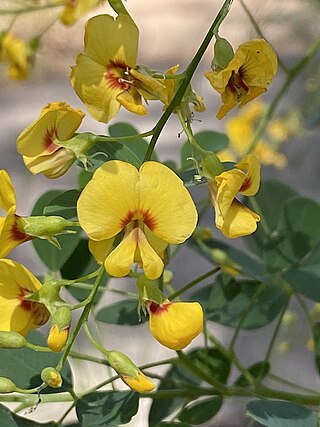
Goodia lotifolia, commonly known as golden tip or clover tree, is a species of flowering plant in the family Fabaceae and is endemic to eastern Australia. It is a sometimes tall shrub with trifoliate leaves, the leaflets narrowly egg-shaped with the narrower end towards the base, and bright yellow, pea-like flowers with red or brown markings.
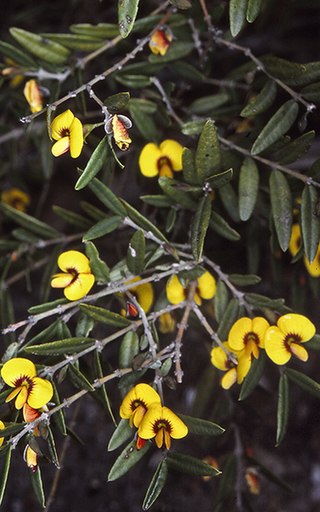
Bossiaea kiamensis is a species of flowering plant in the family Fabaceae and is endemic to the south coast of New South Wales. It is an erect or prostrate shrub with narrow elliptic or narrow oblong leaves and yellow and red to brown flowers.

Pultenaea reflexifolia, commonly known as wombat bush-pea, is a species of flowering plant in the family Fabaceae and is endemic to isolated parts of Victoria. It is an erect shrub with its foliage covered with tangled hairs, and has elliptic to narrow egg-shaped leaves with the narrower end towards the base, and yellow and red pea-like flowers arranged singly or in pairs on the ends of short side branches.
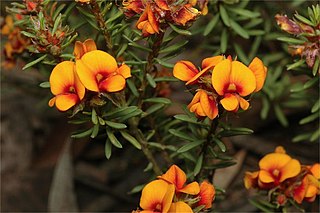
Pultenaea subspicata, commonly known as low bush-pea, is a species of flowering plant in the family Fabaceae and is endemic to south-eastern continental Australia. It is a low-lying, prostrate or mat-forming shrub with elliptic leaves and yellow to pink and orange-red, pea-like flowers.
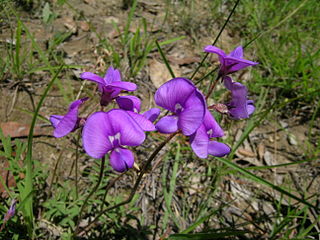
Swainsona monticola, commonly known as notched Swainson-pea, is a flowering plant in the pea family Fabaceae and grows in New South Wales and the Australian Capital Territory. It is an upright or sprawling perennial with fern-like leaves and purple pea flowers.

Daviesia reclinata is a species of flowering plant in the family Fabaceae and is endemic to northern Australia. It is a prostrate or straggling shrub with scattered linear phyllodes, and yellow flowers.

Swainsona maccullochiana, commonly known as Ashburton pea, is a species of flowering plant in the family Fabaceae. It is an upright annual with purple-reddish, pink or bluish pea-like flowers from spring to summer and is endemic to Western Australia.
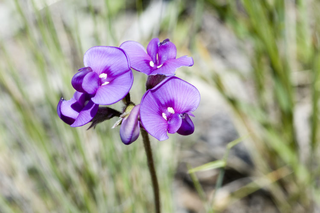
Swainsona sericea commonly known as silky Swainson-pea or silky pea, is a flowering plant in the family Fabaceae. It is a small perennial with greyish-green leaves, purple flowers and grows in New South Wales, Victoria and South Australia.
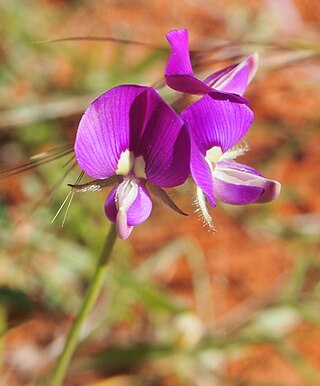
Swainsona phacoides commonly known as dwarf Swainson-pea or lilac Darling pea, is a flowering plant in the family Fabaceae. It is a small perennial herb, usually purple flowers and grows in all mainland states of Australia and the Northern Territory.

Swainsona swainsonioides commonly known as downy Swainson-pea or downy Darling pea,is a flowering plant in the family Fabaceae. It is a small perennial herb with purple flowers and grows in eastern states of Australia.
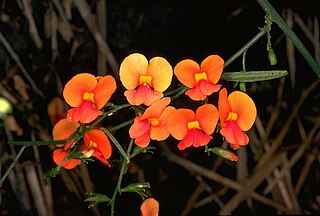
Chorizema diversifolium is a species of flowering plant in the family Fabaceae and is endemic to the southwest of Western Australia. It is a twining or trailing shrub or climber with variably-shaped, egg-shaped to narrowly lance-shaped leaves and pink, orange and red flowers.
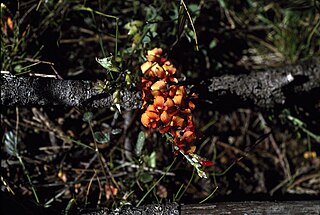
Chorizema humile is a species of flowering plant in the family Fabaceae and is endemic to the southwest of Western Australia. It is a sprawling, prostrate or low-lying shrub with egg-shaped or wedge-shaped leaves and yellow and reddish-brown flowers.
Swainsona acuticarinata is a species of flowering plant in the family Fabaceae and is endemic to arid areas of central Australia. It is a prostrate perennial herb with imparipinnate leaves with 5 to 11 leaflets, and racemes of purple flowers.
Swainsona adenophylla, commonly known as violet swainson-pea or violet Darling pea, is a species of flowering plant in the family Fabaceae and is endemic to arid areas of central Australia. It is a slender, erect or spreading perennial herb with imparipinnate leaves with three to nine linear to narrowly egg-shaped leaflets, and racemes of pink or purplish flowers in racemes of ten to twenty.
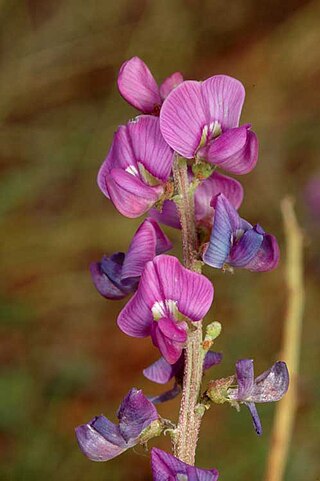
Swainsona affinis, commonly known as common poison pea, is a species of flowering plant in the family Fabaceae and is endemic to arid areas of inland Australia. It is a prostrate perennial herb with imparipinnate leaves with 7 to 25 broadly elliptic leaflets, and racemes of purple, pink, yellow or white flowers.

Swainsona beasleyana is a species of flowering plant in the family Fabaceae and is endemic to inland areas of Western Australia. It is a low-lying perennial herb with imparipinnate leaves usually with 15 to 19 egg-shaped leaflets with the narrower end towards the base, and racemes of 3 to 8 pale or dark purple flowers.
Swainsona bracteata is a species of flowering plant in the family Fabaceae and is endemic to eastern Australia. It is a perennial herb with imparipinnate leaves usually with 19 to 25 narrowly egg-shaped leaflets, and racemes of about 20 white, pale pink or pale purple flowers.


















